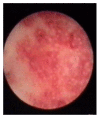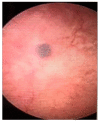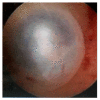Diagnosis and Treatment of Adenomyosis with Office Hysteroscopy-A Narrative Review of Literature
- PMID: 37443576
- PMCID: PMC10340732
- DOI: 10.3390/diagnostics13132182
Diagnosis and Treatment of Adenomyosis with Office Hysteroscopy-A Narrative Review of Literature
Abstract
Introduction: Adenomyosis is a common chronic disease in women of reproductive age, characterised by the presence of ectopic endometrial tissue within myometrium. Even though adenomyosis presents with chronic pelvic pain, menorrhagia or abnormal uterine bleeding, dysmenorrhoea, and dyspareunia and is often recognised after hysterectomies. However, the development of ultrasonography and magnetic resonance imaging has improved the pre-operative diagnosis of the disease. Hysteroscopy provides information in real time from the uterine cavity and the offers the possibility of obtaining direct biopsies.
Material and methods: The literature was searched via Pubmed and Embase with the following headings: diagnosis of adenomyosis or adenomyoma and office hysteroscopy, hysteroscopy findings of adenomyosis or adenomyoma, treatment of adenomyosis or adenomyoma with office hysteroscopy.
Results: The literature showed that hysteroscopy can identify superficial adenomyosis. There are a variety of hysteroscopic images that can be connected with the disease. New equipment like the spirotome has been used to access deeper layers of myometrium and obtain biopsies under direct vision from the adenomyotic areas. Different methods of treatment have been also described, like enucleation of focal superficial adenomyoma, coagulation, evacuation of cystic adenomyosis when the lesion is smaller than 1.5 cm, and resection of adenomyotic nodules in case of bigger lesions (>1.5 cm). Diffuse superficial adenomyosis is also managed by resection.
Conclusions: Hysteroscopy has revolutionised the approach to adenomyosis. It is a useful tool in assessing mainly superficial adenomyosis. The role of hysteroscopy in surgical management of adenomyosis need to be confirmed with further studies.
Keywords: adenomyosis; diagnosis; hysteroscopy; management; treatment; vaginoscopic approach.
Conflict of interest statement
The authors declare no conflict of interest.
Figures
Similar articles
-
The Role of Hysteroscopy in the Diagnosis and Treatment of Adenomyosis.Biomed Res Int. 2017;2017:2518396. doi: 10.1155/2017/2518396. Epub 2017 Aug 9. Biomed Res Int. 2017. PMID: 28852646 Free PMC article. Review.
-
Office hysteroscopy and adenomyosis.Best Pract Res Clin Obstet Gynaecol. 2006 Aug;20(4):557-67. doi: 10.1016/j.bpobgyn.2006.01.019. Epub 2006 Mar 22. Best Pract Res Clin Obstet Gynaecol. 2006. PMID: 16554185 Review.
-
Symptoms and classification of uterine adenomyosis, including the place of hysteroscopy in diagnosis.Fertil Steril. 2018 Mar;109(3):380-388.e1. doi: 10.1016/j.fertnstert.2018.01.006. Fertil Steril. 2018. PMID: 29566850 Review.
-
Decidualized juvenile cystic adenomyoma mimicking a cornual pregnancy.Fertil Steril. 2020 Feb;113(2):463-465. doi: 10.1016/j.fertnstert.2019.10.026. Fertil Steril. 2020. PMID: 32106998
-
Hysteroscopic diagnosis and excision of myometrial cystic adenomyosis.Gynecol Surg. 2014;11(4):273-278. doi: 10.1007/s10397-014-0861-5. Epub 2014 Oct 3. Gynecol Surg. 2014. PMID: 25419204 Free PMC article.
Cited by
-
Epidemiology of endometriosis in Kazakhstan: a national population-based cohort analysis (2014-2019) using data from the national electronic healthcare system.Front Med (Lausanne). 2025 Jan 7;11:1436458. doi: 10.3389/fmed.2024.1436458. eCollection 2024. Front Med (Lausanne). 2025. PMID: 39839642 Free PMC article.
References
-
- Habiba M., Benagiano G. Uterine Adenomyosis. Springer; Cham, Switzerland: 2016.
-
- Ryo E., Takeshita S., Shiba M., Ayabe T. Radiofrequency ablation for cystic adenomyosis: A case report. J. Reprod. Med. 2006;51:427–430. - PubMed
Publication types
LinkOut - more resources
Full Text Sources






